How would you react if you received a text message like this?
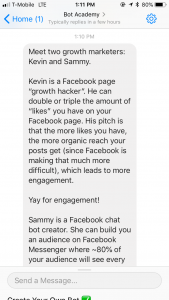
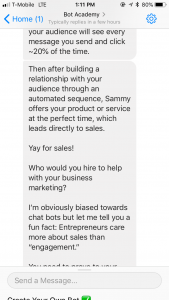
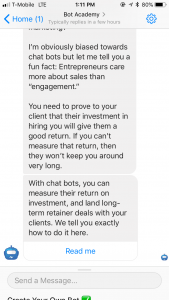
Oh my goodness. If someone sent that to me, I would unfriend them. Just kidding. Or maybe I’m half kidding.
That is way too long of a text to read and unless I have a close relationship with them, I would have “marked as read” and go on about my day.
But the bot creators I’ve seen (who obviously has not gone through our Bot Academy course) are sending messages as if they are sending long emails.
So how do you write messages for your chatbot that your audience will love to read?
After going through hundreds of chatbots, building dozens of chatbots, and reviewing our student’s chatbots, we have a clear understanding of what kind of messages perform well.
It’s not as simple as “keep the messages short.” You have to understand WHY short messages perform better. That understanding will help with everything else you do in marketing.
We will explain our philosophy behind chatbots and the three main lessons you can take away to write messages that people love.
- Understand who your avatar is… and communicate in their language.
- Teach through stories!
- Use curiosity to drive engagement
We will break down good and bad examples so you can learn what would be best for you and your chatbot. Let’s dive in.
Why chatbots over email
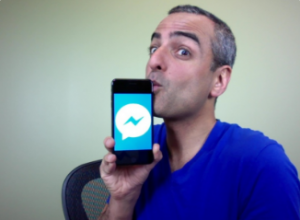
When Andrew (founder of Bot Academy) wants to communicate with the most important people in his life, he noticed that he is exclusively using chat apps.
iMessage for his wife. Facebook Messenger for his friends. Basecamp to talk with his team.
He noticed that he never uses email and actually prefers to chat, any day of the week. Andrew asked his friends how they communicate with their loved ones and they had the same answer too: chat apps over email.
Our core job as marketers is to go to where the people are and show how our product or service can solve their problem. Why should we spend all our efforts on email marketing when our customers are using Messenger?.
Now we teach freelancers and agency owners how to use chatbots for their businesses or their clients. But the transition for some students was not that easy.
Many of our students came from the email marketing world and was used to it. But they are trying to do what works in email inside Messenger.
They are copy and pasting essays that they would normally send as a newsletter into a chat app that people see messages and respond within seconds.
This does not work.
All the platforms are unique. What you post on Facebook might not do as well on YouTube. What you post on Instagram might not do as well on Twitter.
Each platform has their own rules and norms.
With Facebook Messenger, or any chat apps, the general philosophy is to write copy as if you were texting a friend.
This means you are NOT writing 1037 words into your little Messenger bubble.
Writing copy for Messenger means you are keeping it short and simple. You can use images, GIFs, and emojis to make it fun.
Once you unlearn what you know and adopt this new mindset, this frame will make it easier to understand the three main lessons. Starting with…
Understand who your avatar is and communicate in their language
This is the most overstated thing you might hear when you learn marketing and business. But I have to repeat it because so many people still don’t do this.
You need to understand who exactly you are talking to and the best to communicate with them.
This meant that if you asked me to review your chatbot copy, I would not be that much help to you.
if I am really great at speaking to entrepreneurs and you have an audience of fashion bloggers who might not be an entrepreneur, how would I know how to best communicate with them?
I would have to spend some time asking you questions like:
- Who is your target audience?
- What problem are you solving?
- What’s your #1 business goal?
- What type of messaging has worked and failed in the past?
Any marketer who doesn’t ask you these questions and gives you feedback is a rookie with good intentions.

Tam's Take
Our friend John Lee Dumas, founder of Entrepreneur on Fire, has a great breakdown on how to find your ideal avatar. Click the button below and I’ll send you his report.
Teaching through stories
There’s so much evidence behind how we remember things and they all come back to storytelling.

When we create messages with our chatbots, we want to make sure that every message is telling a captivating story.
The most common way to do this within Messenger is through an automated drip sequence, which is a set of messages that get sent out (or dripped) to your audience every few days automatically.
You should have two goals for your sequence:
- Achieving your business goal (like selling your product)
- Solving your subscriber’s burning problem (like learning how to meal prep for vegans)
If your chatbot is in fitness and is teaching people how to lose weight, messages like
“Eat healthier”
“Drink more water”
“Workout three times a week.”
Most people know that they should problem work out more or eat healthier. People who are trying to lose weight actually don’t need more education. One of the things that need are stories that stick with them to potentially motivate, inspire, and change their behavior.

A story that did this well was Subway when a customer, Jared Fogle, lost 245 pounds eating Subway everyday for a year.
I don’t really care about Subway or know much about this Jared guy, but I will never forget the ridiculous story of how eating sandwiches made someone lose so much weight.
Inside your messages, you want to share stories that stick with your audience.

Tam's Take
I used to be the weird one in a group that would start telling a story and make everyone look away because I took too long or everything was so scattered. I decided to devote my efforts (and later my career) to learning how to tell good stories which helped me publish two books, write 100+ articles, and deliver a speech to 4,000+ high school students.
Click the button below for my favorite resources on storytelling.
Use curiosity to drive engagement
We want people to be engaged and have them excited on what is coming up next. The more they click, the more engaged they are. Not only is creating great content beneficial for your audience, it’s a very easy qualifier to see who will be your “true fans.”
And if your content is not as great as you think it is based on the data, you should ask yourself: Why am I getting low open and click rates? Usually, that means the content is not specific or relevant to your customers.
You would go back to the user research and your avatar to see how you can make that even more precise.
I want to show you a few examples of how we do this at Bot Academy. To give context, our general audience is marketers and freelancers who want to learn how to build chatbots for their businesses or for clients.
Message 1: Mind blowing realization
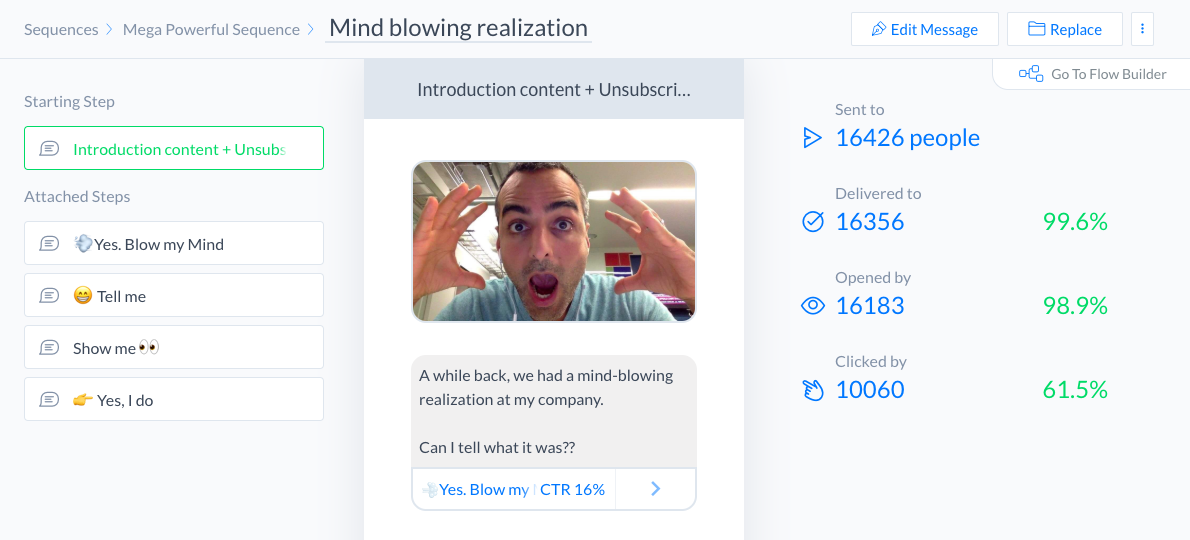
This is the first message people receive when they subscribe to our sequence.
This is Andrew Warner, founder of Bot Academy, and right off the bat… you can tell how playful this is going to be. You have the CEO giving a funny facial expression with his hands hovering above his head.
Now notice the copy. We ended it with a vague “Can I tell what it was??” because we want people to be curious and continue to click. 16% did.
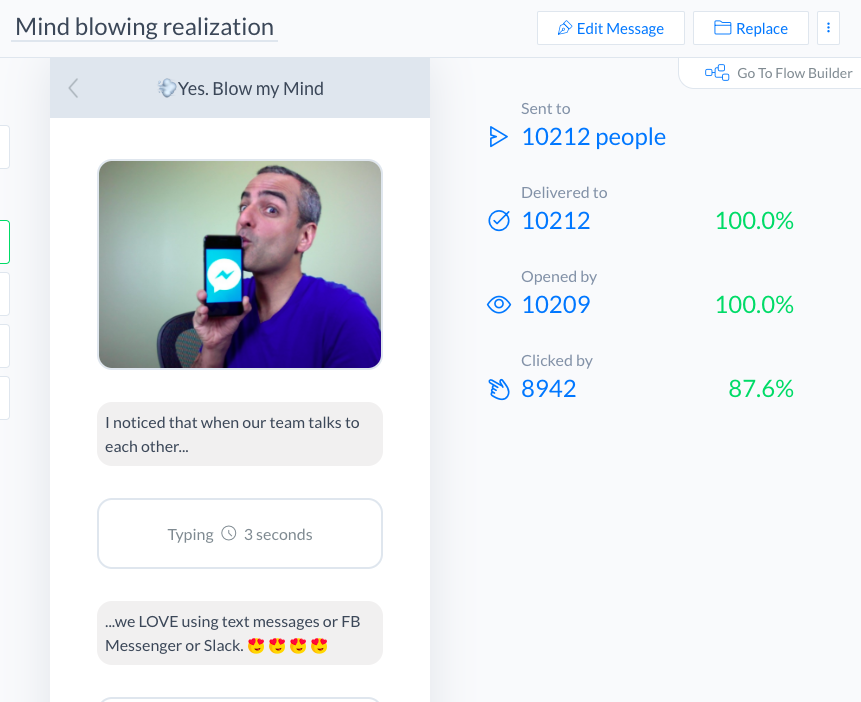
The playful side of Andrew is coming out again with a photo of him kissing his phone with a photo of Messenger’s logo.
We are adding short sentences, typing delay, and emojis.
Can you already see the difference between communicating on Messenger and email?
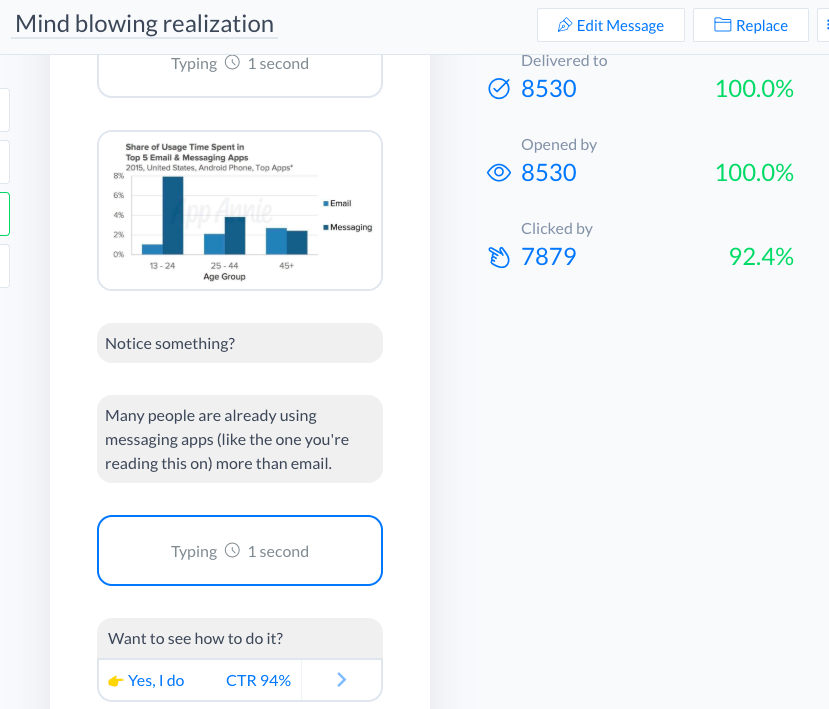
You can show charts as well if you’re not the kind of playful person that Andrew is (he can be quite the kid, in many good ways).
We are teaching through a story about how email sucks and messenger is growing. We continue to use curiosity to make people click further which 94% of them did here.
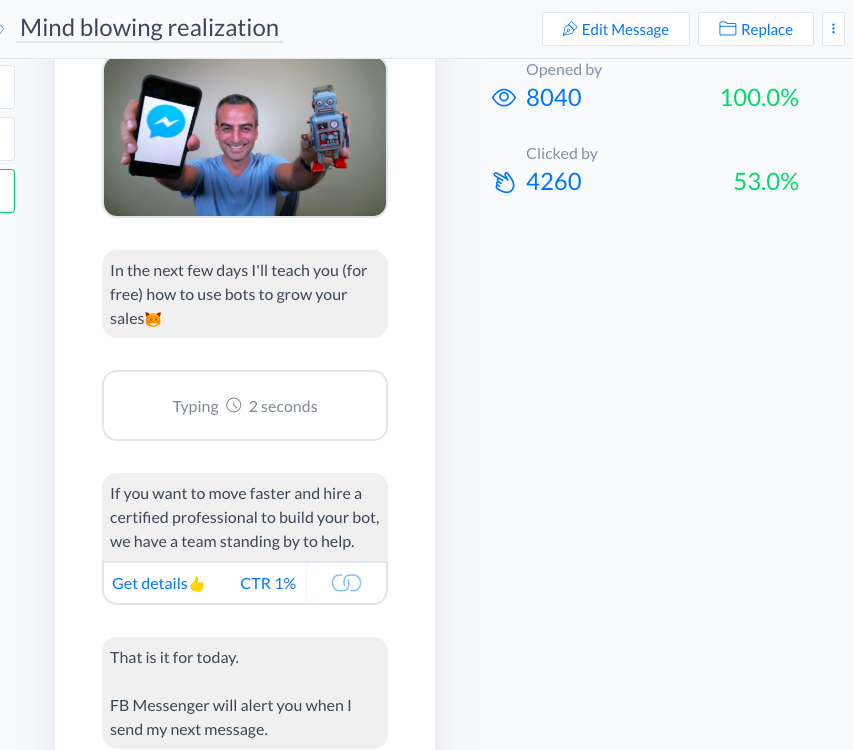
This is the end of our first message.
We give a little teaser and a non-pitch pitch (more on this in our Bot Academy course) to end off the first day.
We also subtly set their expectations by telling them we will send more messages and teach.
The main point is that we are teaching through stories and we use curiousity to keep people engaged.
Let’s take another message in our sequence.
Message 2: What is a bot?
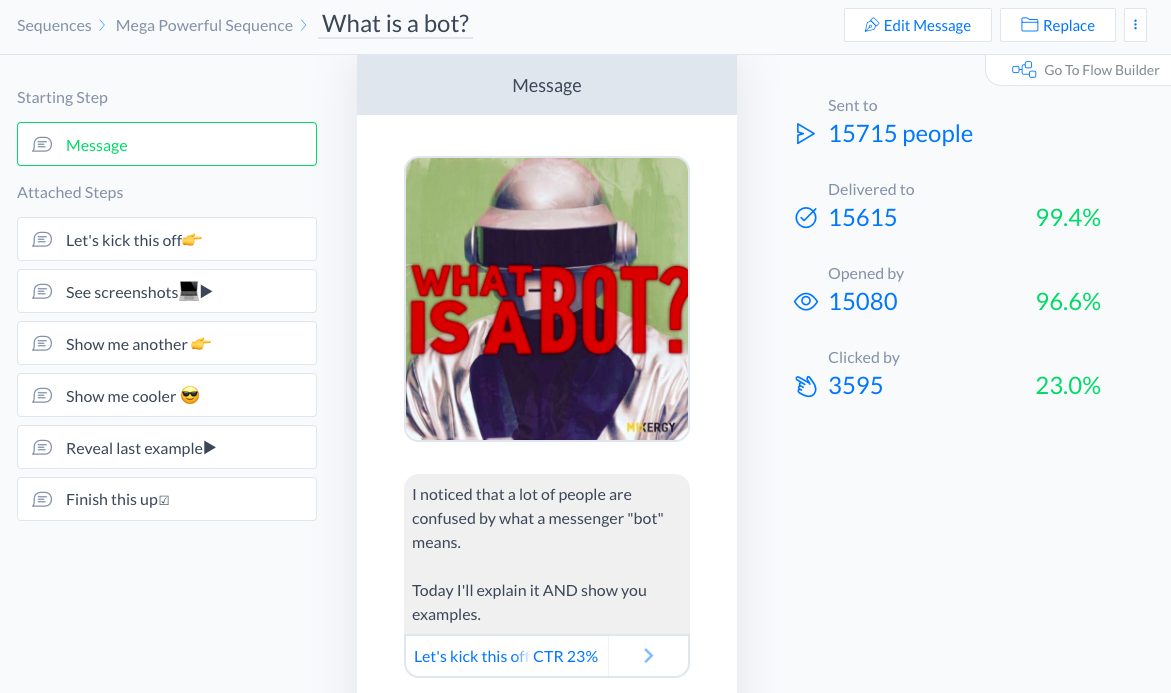
This is another example of explaining what a chatbot is.
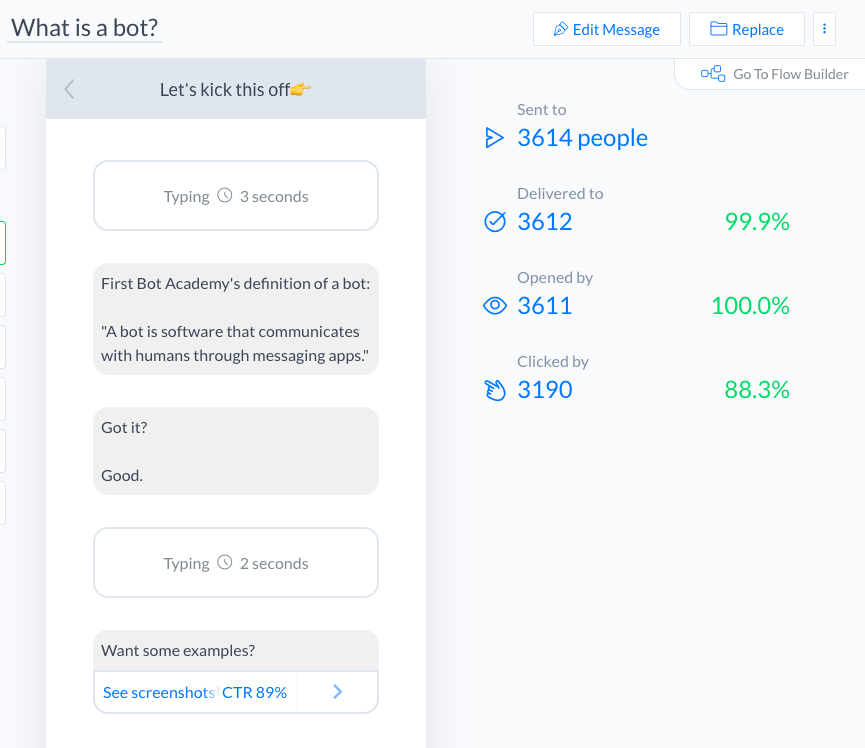
We explain what we think of chatbots and offer examples if they click more which 88.3% of them did.
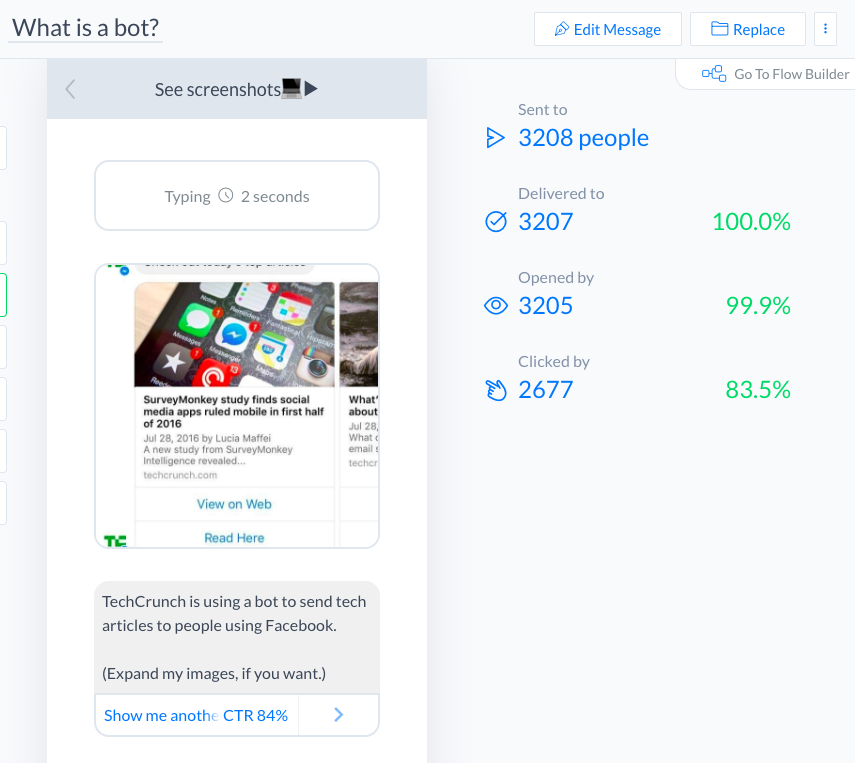
We showcase TechCrunch’s bot.
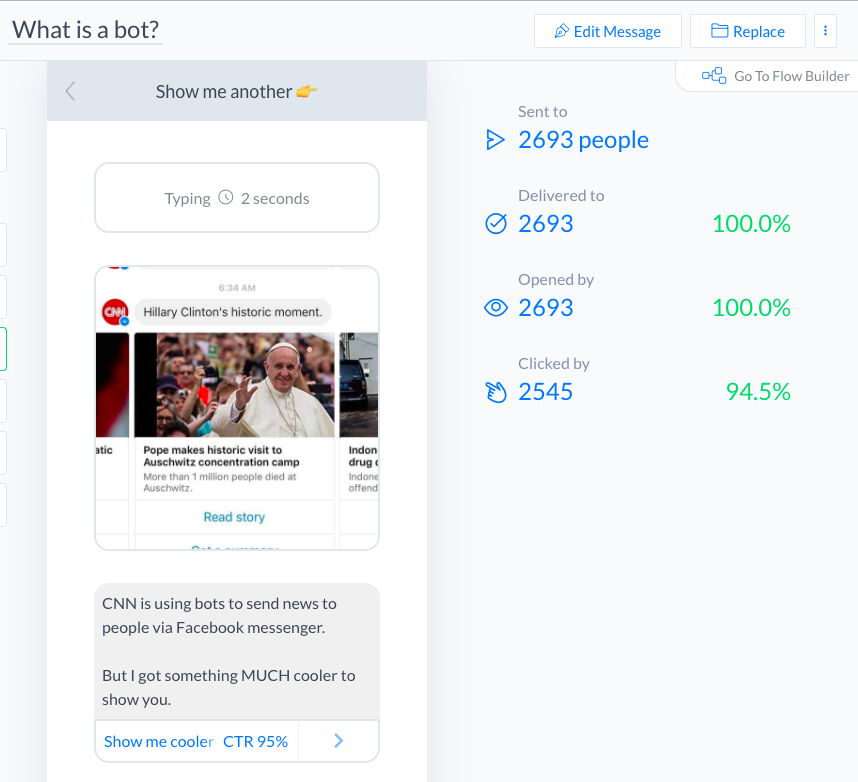
We show CNN’s chatbot, but it honesty kinda sucks.
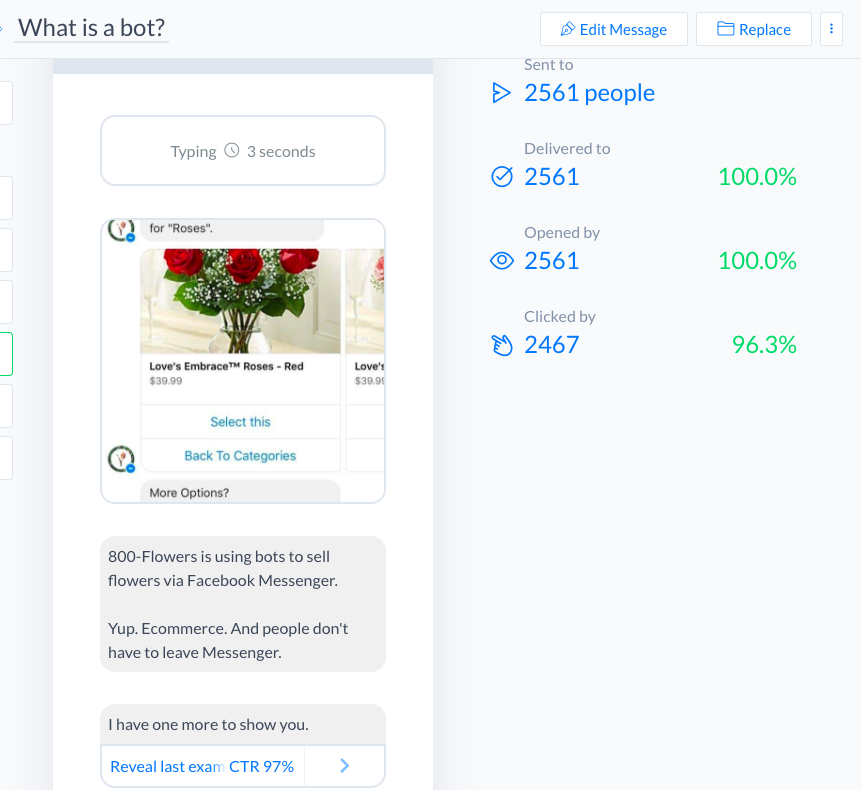
We show 800-Flowers chatbots. Notice how this is the 5th message inside this flow and 97% people are still clicking through.
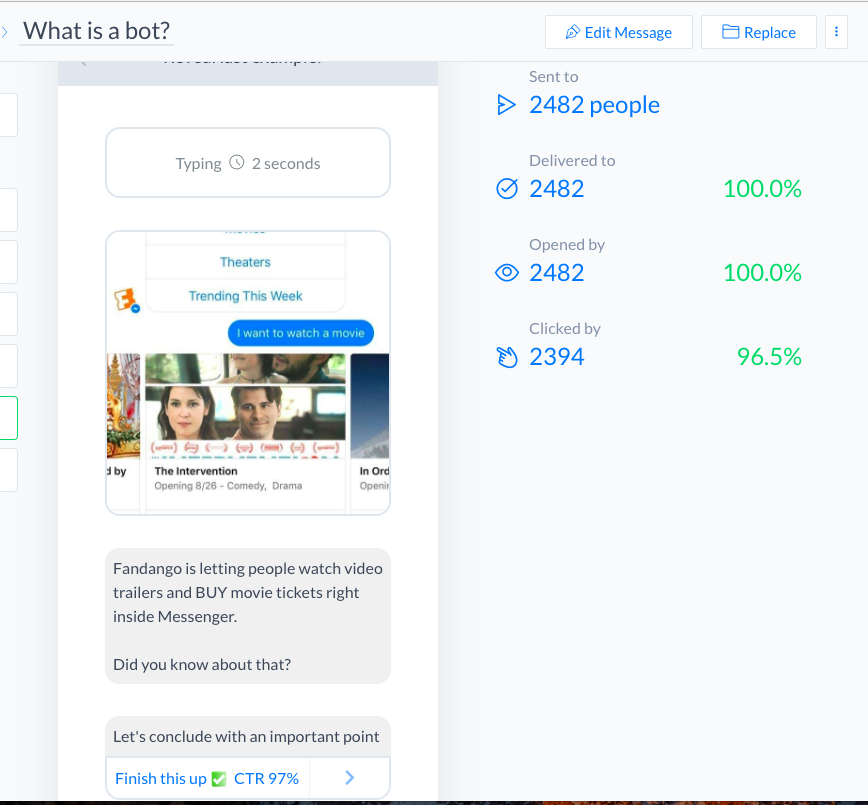
We show Fandango’s chatbot and how you can buy movie tickets directly from Meseenger. One last button to end it off!
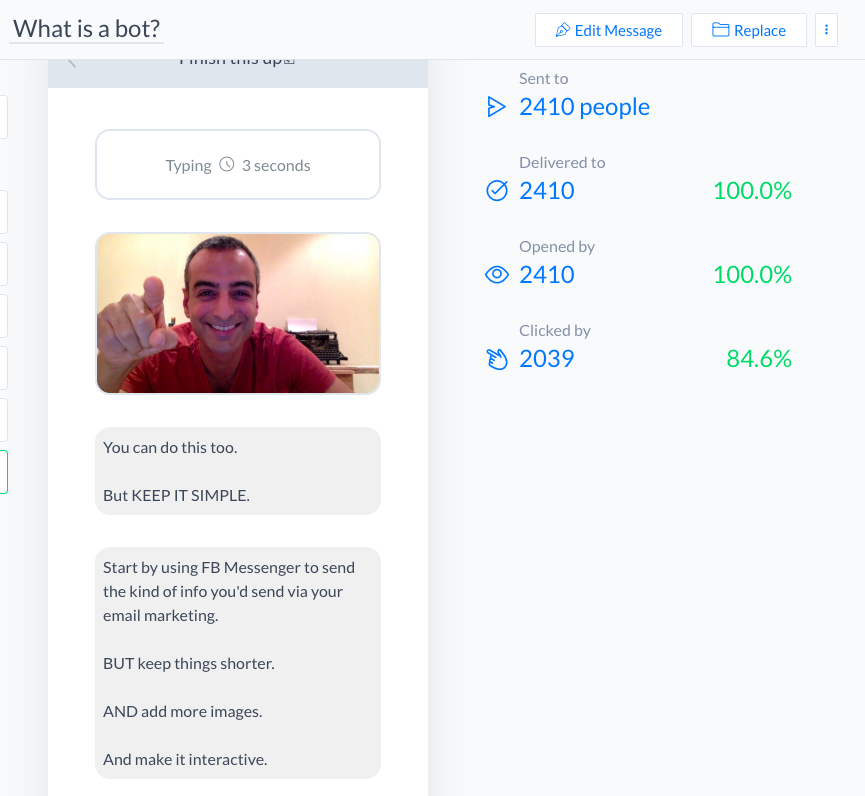
This is kind of meta because the tips from the chatbot are what I’m trying to teach now.
Keep things shorter. Add images. Keep it simple. Make it interactive.
Notice that this message was all the very last message of the flow and clicked by 2039 people. We “tag” all our messages so we know who our trues fans are vs. casual readers.

Tam's Take
Your main priority in business is to identify who your true fans are. Kevin Kelly, founder of WIRED magazine, argues in a fantastic piece that once you have 1000 true fans… you will be able to be successful.
Click the button below and I’ll send you a link to the piece that has been shared thousands of times between entrepreneurs and creatives.
Wrap-up
It’s nice to geek out about the coolest integrations you make with your chat platform or talk about artificial intelligence within your chatbot. But don’t skip the most important marketing principles.
Understand your avatar, teach through stories, and use curiosity to drive engagement. These three lessons will ground you and set the frame for your chatbot messages.
Good luck with on your chatbot journey!

